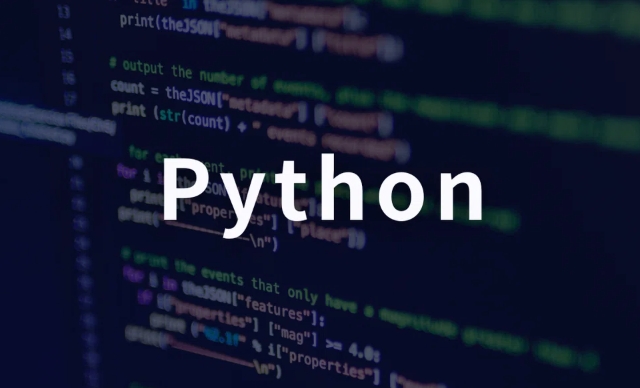To determine whether there are any elements in the Python list that meet the criteria, it is recommended to use the any() function with the generator expression. 1. any() is a built-in function. As long as one element is true, it returns True; 2. Use generator expressions to achieve efficient and lazy evaluation to avoid memory waste; 3. Any() returns False in an empty list; 4. It can be used for judgments of various data types, such as strings, object properties, etc.; 5. Compared with manual traversal or filter methods, any() is more concise and efficient, and is the preferred solution. For example: if any(num % 2 == 1 for num in numbers): print("Odd number exists").

Determining whether there are elements in a list that meet a certain condition is a common operation in Python programming. If you want to know "How to determine whether any element in a list meets the criteria in Python", the simplest and most efficient way is to use any() function to cooperate with the generator expression.

How to use any() to determine whether there are elements in the list that meet the criteria
any() is a built-in function in Python. As long as there is an element true, it will return True . Combining a generator expression allows judgment to be completed very efficiently.
For example:

numbers = [2, 4, 6, 7, 8]
if any(num % 2 == 1 for num in numbers):
print("Odd number exists") The above code checks whether there is at least one odd number in the numbers list. Once an element that meets the criteria is found (7 here), True is returned immediately and the entire list will not continue to traverse.
This method is not only concise in writing, but also efficient, and is suitable for handling large lists or scenarios that require frequent judgment.

Common usage and precautions
Don't write the generator into a list comprehension
Although both of the following writing methods can be run:any([num % 2 == 1 for num in numbers]) # Not recommended any(num % 2 == 1 for num in numbers) # Recommended
But the first type will create the entire list and pass it to
any(), while the second type is a lazy evaluation generator that saves memory.Pay attention to the empty list
If the list is empty,any()returnsFalse:any(x > 0 for x in []) # Return to False
Suitable for various types of data judgment
For example, strings, object properties, etc. can be judged in a similar way:names = ["Alice", "Bob", "Charlie"] if any(name.startswith("A") for name in names): print("There is a name that starts with A")
Comparison of other alternative methods
Although any() is the preferred solution, there are some other writing methods that can implement similar functions, but each has its advantages and disadvantages:
Manually traverse the list
found = False for number in numbers: if num % 2 == 1: found = True break if found: print("Odd number exists")The writing is lengthy and not Pythonic enough.
Use filter bool to judge
if list(filter(lambda x: x % 2 == 1, numbers)): print("Odd number exists")Although it can work, it is not as concise and efficient as
any()Moreover,filterreturns an iterator in Python3, and cannot directly judge true or false unless converted into a list.
Basically that's it. Using
any()with generator expressions is the clearest and efficient way to judge. It is recommended to use more in actual projects.The above is the detailed content of python if any item in list. For more information, please follow other related articles on the PHP Chinese website!

Hot AI Tools

Undress AI Tool
Undress images for free

Undresser.AI Undress
AI-powered app for creating realistic nude photos

AI Clothes Remover
Online AI tool for removing clothes from photos.

Clothoff.io
AI clothes remover

Video Face Swap
Swap faces in any video effortlessly with our completely free AI face swap tool!

Hot Article

Hot Tools

Notepad++7.3.1
Easy-to-use and free code editor

SublimeText3 Chinese version
Chinese version, very easy to use

Zend Studio 13.0.1
Powerful PHP integrated development environment

Dreamweaver CS6
Visual web development tools

SublimeText3 Mac version
God-level code editing software (SublimeText3)
 VSCode settings.json location
Aug 01, 2025 am 06:12 AM
VSCode settings.json location
Aug 01, 2025 am 06:12 AM
The settings.json file is located in the user-level or workspace-level path and is used to customize VSCode settings. 1. User-level path: Windows is C:\Users\\AppData\Roaming\Code\User\settings.json, macOS is /Users//Library/ApplicationSupport/Code/User/settings.json, Linux is /home//.config/Code/User/settings.json; 2. Workspace-level path: .vscode/settings in the project root directory
 How to handle transactions in Java with JDBC?
Aug 02, 2025 pm 12:29 PM
How to handle transactions in Java with JDBC?
Aug 02, 2025 pm 12:29 PM
To correctly handle JDBC transactions, you must first turn off the automatic commit mode, then perform multiple operations, and finally commit or rollback according to the results; 1. Call conn.setAutoCommit(false) to start the transaction; 2. Execute multiple SQL operations, such as INSERT and UPDATE; 3. Call conn.commit() if all operations are successful, and call conn.rollback() if an exception occurs to ensure data consistency; at the same time, try-with-resources should be used to manage resources, properly handle exceptions and close connections to avoid connection leakage; in addition, it is recommended to use connection pools and set save points to achieve partial rollback, and keep transactions as short as possible to improve performance.
 python itertools combinations example
Jul 31, 2025 am 09:53 AM
python itertools combinations example
Jul 31, 2025 am 09:53 AM
itertools.combinations is used to generate all non-repetitive combinations (order irrelevant) that selects a specified number of elements from the iterable object. Its usage includes: 1. Select 2 element combinations from the list, such as ('A','B'), ('A','C'), etc., to avoid repeated order; 2. Take 3 character combinations of strings, such as "abc" and "abd", which are suitable for subsequence generation; 3. Find the combinations where the sum of two numbers is equal to the target value, such as 1 5=6, simplify the double loop logic; the difference between combinations and arrangement lies in whether the order is important, combinations regard AB and BA as the same, while permutations are regarded as different;
 Mastering Dependency Injection in Java with Spring and Guice
Aug 01, 2025 am 05:53 AM
Mastering Dependency Injection in Java with Spring and Guice
Aug 01, 2025 am 05:53 AM
DependencyInjection(DI)isadesignpatternwhereobjectsreceivedependenciesexternally,promotingloosecouplingandeasiertestingthroughconstructor,setter,orfieldinjection.2.SpringFrameworkusesannotationslike@Component,@Service,and@AutowiredwithJava-basedconfi
 python pytest fixture example
Jul 31, 2025 am 09:35 AM
python pytest fixture example
Jul 31, 2025 am 09:35 AM
fixture is a function used to provide preset environment or data for tests. 1. Use the @pytest.fixture decorator to define fixture; 2. Inject fixture in parameter form in the test function; 3. Execute setup before yield, and then teardown; 4. Control scope through scope parameters, such as function, module, etc.; 5. Place the shared fixture in conftest.py to achieve cross-file sharing, thereby improving the maintainability and reusability of tests.
 Python for Data Engineering ETL
Aug 02, 2025 am 08:48 AM
Python for Data Engineering ETL
Aug 02, 2025 am 08:48 AM
Python is an efficient tool to implement ETL processes. 1. Data extraction: Data can be extracted from databases, APIs, files and other sources through pandas, sqlalchemy, requests and other libraries; 2. Data conversion: Use pandas for cleaning, type conversion, association, aggregation and other operations to ensure data quality and optimize performance; 3. Data loading: Use pandas' to_sql method or cloud platform SDK to write data to the target system, pay attention to writing methods and batch processing; 4. Tool recommendations: Airflow, Dagster, Prefect are used for process scheduling and management, combining log alarms and virtual environments to improve stability and maintainability.
 How to work with Calendar in Java?
Aug 02, 2025 am 02:38 AM
How to work with Calendar in Java?
Aug 02, 2025 am 02:38 AM
Use classes in the java.time package to replace the old Date and Calendar classes; 2. Get the current date and time through LocalDate, LocalDateTime and LocalTime; 3. Create a specific date and time using the of() method; 4. Use the plus/minus method to immutably increase and decrease the time; 5. Use ZonedDateTime and ZoneId to process the time zone; 6. Format and parse date strings through DateTimeFormatter; 7. Use Instant to be compatible with the old date types when necessary; date processing in modern Java should give priority to using java.timeAPI, which provides clear, immutable and linear
 Understanding the Java Virtual Machine (JVM) Internals
Aug 01, 2025 am 06:31 AM
Understanding the Java Virtual Machine (JVM) Internals
Aug 01, 2025 am 06:31 AM
TheJVMenablesJava’s"writeonce,runanywhere"capabilitybyexecutingbytecodethroughfourmaincomponents:1.TheClassLoaderSubsystemloads,links,andinitializes.classfilesusingbootstrap,extension,andapplicationclassloaders,ensuringsecureandlazyclassloa






